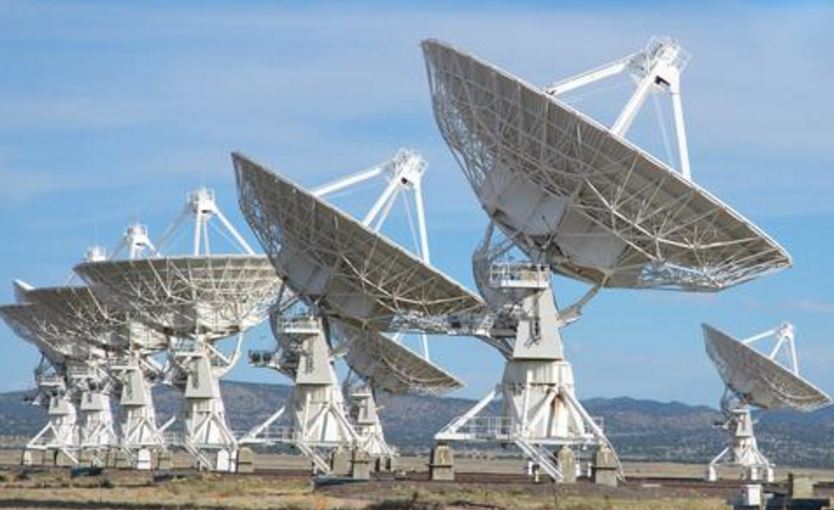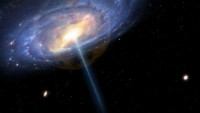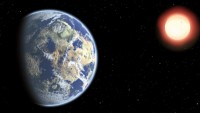New Model Reveals How the Universe Became ‘Transparent’
| Arthur Dominic Villasanta | | Sep 14, 2016 03:08 AM EDT |
(Photo : UC Riverside) Reionization as illustrated by data from the Hubble and Chandra space telescopes.
Two papers present an alternate explanation of the cosmic reionization that made the Universe "transparent" to ultraviolet radiation, allowing the release of light to travel almost freely through the cosmos.
Reionization usually refers to the reionization of hydrogen gas and has become a major area of research in astrophysics.
Like Us on Facebook
The study led by Naveen Reddy, an assistant professor in the Department of Physics and Astronomy at the University of California Riverside, marks the first quantitative study of how the gas content within galaxies scales with the amount of interstellar dust.
This analysis shows that the gas in galaxies is like a "picket fence," where some parts of the galaxy have little gas and are directly visible, whereas other parts have lots of gas and are effectively opaque to ionizing radiation. The findings were just published in The Astrophysical Journal.
The ionization of hydrogen is important because of its effects on how galaxies grow and evolve. A particular area of interest is assessing the contribution of different astrophysical sources, such as stars or black holes, to the causes of ionizing radiation.
Most studies suggest faint galaxies are responsible for providing enough radiation to ionize the gas in the early history of the universe. There is also anecdotal evidence the amount of ionizing radiation able to escape from galaxies depends on the amount of hydrogen within the galaxies themselves.
The research team led by Reddy developed a model that can be used to predict the amount of escaping ionizing radiation from galaxies based on straightforward measurements on how "red," or dusty, their spectra appear to be.
Alternatively, with direct measurements of the ionizing escape fraction, their model may be used to constrain the intrinsic production rate of ionizing photons at around two billion years after the Big Bang.
These practical applications of the model will be central to the interpretation of escaping radiation during the cosmic "dark ages," a topic that is bound to flourish with the coming of 30-meter telescopes, which will allow for research unfeasible today, and the James Webb Space Telescope, NASA's next orbiting observatory and the successor to the Hubble Space Telescope.
The research ties back to some 400,000 years after the Big Bang, when the universe entered the cosmic "dark ages" where galaxies and stars had yet to form among the dark matter, hydrogen and helium.
A few hundred million years later, the Universe entered the "Epoch of Reionization" where the gravitational effects of dark matter helped hydrogen and helium coalesce into stars and galaxies. A large amount of ultraviolet radiation (photons) was released, stripping electrons from surrounding neutral environments, a process known as "cosmic reionization."
Tagscosmic reionization, Universe, Naveen Reddy, University of California Riverside, ionization, Hydrogen
©2015 Chinatopix All rights reserved. Do not reproduce without permission
 SETI Plods on in Search for ET despite Pessimism but Buoyed by $100 Million in Funding
SETI Plods on in Search for ET despite Pessimism but Buoyed by $100 Million in Funding Scientists Discover Where the Milky Way’s Missing Mass Went
Scientists Discover Where the Milky Way’s Missing Mass Went Scientists Discover Dragonfly 44, a Galaxy that’s 99.99% Dark Matter
Scientists Discover Dragonfly 44, a Galaxy that’s 99.99% Dark Matter New Theory says Intelligent Life Evolved on Earth too Fast Compared to the Rest of the Universe
New Theory says Intelligent Life Evolved on Earth too Fast Compared to the Rest of the Universe
EDITOR'S PICKS
-

Did the Trump administration just announce plans for a trade war with ‘hostile’ China and Russia?
-

US Senate passes Taiwan travel bill slammed by China
-

As Yan Sihong’s family grieves, here are other Chinese students who went missing abroad. Some have never been found
-

Beijing blasts Western critics who ‘smear China’ with the term sharp power
-

China Envoy Seeks to Defuse Tensions With U.S. as a Trade War Brews
-

Singapore's Deputy PM Provides Bitcoin Vote of Confidence Amid China's Blanket Bans
-

China warns investors over risks in overseas virtual currency trading
-

Chinese government most trustworthy: survey
-

Kashima Antlers On Course For Back-To-Back Titles
MOST POPULAR
LATEST NEWS
Zhou Yongkang: China's Former Security Chief Sentenced to Life in Prison

China's former Chief of the Ministry of Public Security, Zhou Yongkang, has been given a life sentence after he was found guilty of abusing his office, bribery and deliberately ... Full Article
TRENDING STORY

China Pork Prices Expected to Stabilize As The Supplies Recover

Elephone P9000 Smartphone is now on Sale on Amazon India

There's a Big Chance Cliffhangers Won't Still Be Resolved When Grey's Anatomy Season 13 Returns

Supreme Court Ruled on Samsung vs Apple Dispute for Patent Infringement

Microsoft Surface Pro 5 Rumors and Release Date: What is the Latest?










